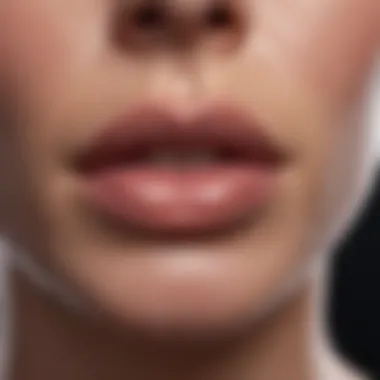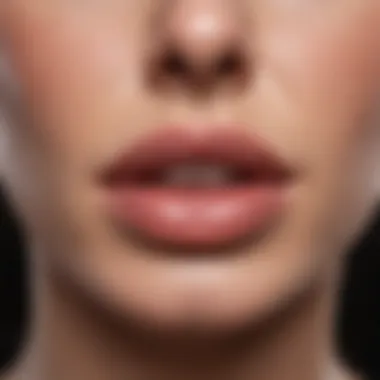Comprehensive Guide to Treating Lip Blisters Effectively


Intro
Blisters on the lips can arise suddenly, causing discomfort and inconvenience. Understanding the nuances behind these blisters is crucial for effective treatment and prevention. This guide explores the many aspects of lip blisters, their causes, symptoms, and the ways to manage and prevent this condition. It aims to equip health professionals, wellness coaches, nutritionists, fitness trainers, and mindfulness instructors with valuable knowledge that can be shared with their clients.
Recognizing the impact of blisters on an individual's overall wellness is vital. People often overlook lip health, which can affect confidence and social interactions. Blisters may be simple, but their underlying causes often require careful consideration. This discourse will provide a comprehensive insight that encourages informed decision-making in managing lip blisters.
Understanding Blisters on Lips
Understanding blisters on lips is fundamental to both recognizing and effectively treating this common issue. Blisters can be more than just a nuisance; they often signal underlying conditions that require attention. By grasping the nuances surrounding lip blisters, one deploys a proactive approach to their health. This knowledge empowers health professionals and wellness enthusiasts alike in guiding clients or themselves through effective treatment paths, enhancing overall well-being.
Definition of Lip Blisters
Lip blisters are fluid-filled sacs that form on or around the lips. These can be small or large and might appear singularly or in clusters. They vary in color, typically being clear, bluish, or red, depending on the underlying cause. Blisters arise as a protective response of the skin when it has been compromised or irritated. While lip blisters are often temporary, understanding their origins is crucial for tailored treatment.
Common Symptoms
Identifying lip blisters involves observing several symptoms:
- Pain and discomfort: Often, the blisters cause soreness that may escalate with movement or contact.
- Itching or tingling: Prior to the appearance of blisters, individuals might experience a tingling sensation.
- Swelling: Surrounding skin may appear swollen or inflamed.
- Visible blisters: The most definitive symptom, which might weep or scab over time.
The presence of these symptoms provides vital clues regarding the nature of the blister and possible courses of action.
Causes of Lip Blisters
Various factors can lead to the formation of blisters on the lips:
- Viral infections: Herpes simplex virus is a primary cause, resulting in painful, recurrent blisters.
- Allergic reactions: Certain food products or lip care substances may trigger an immune response, leading to blister formation.
- Physical irritation: Friction from rubbing against surfaces, or biting the lips can cause blisters from damage.
- Environmental factors: Sunburn or cold weather can contribute to lip blistering due to dryness or excessive heat.
Recognizing these causes enhances awareness and enables individuals to take preventive measures appropriately. Understanding these aspects creates a foundation for effectively treating lip blisters and mitigating their recurrence in the future.
Types of Blisters Found on Lips
Understanding the different types of blisters that can form on the lips is crucial for effective treatment and prevention strategies. This section elaborates on specific blister types, helping readers identify their condition and take appropriate action. Furthermore, recognizing the variety of blisters facilitates more targeted and effective treatment options, enhancing overall lip health.
Herpetic Blisters
Herpetic blisters are primarily caused by the herpes simplex virus, most often type 1. They typically appear at the edge of the lips or around the mouth. These blisters can be painful and are often accompanied by itching or tingling sensations prior to their appearance. The fluid-filled vesicles can burst, leading to crusting as they heal. It is essential to differentiate herpetic blisters from other types, as they are contagious. Therefore, avoiding close contact during an outbreak can help prevent transmission.
Management often includes antiviral medications, which can help reduce the duration and severity of the outbreak. Over-the-counter treatment options are available as well, primarily containing ingredients to alleviate pain and promote healing.
Allergic Reaction Blisters
Allergic reaction blisters arise from hypersensitivity to certain substances, such as cosmetics, food, or medications. They may appear suddenly and can vary in size. Unlike herpetic blisters, these are less likely to involve a viral infection but are more associated with contact dermatitis. Common symptoms include redness, swelling, and itchiness, which often accompany the blisters. Identifying the allergen is a key aspect of treatment. Avoiding the trigger and applying soothing creams can alleviate discomfort. In some cases, antihistamines may help manage allergic symptoms.
Friction Blisters
Friction blisters on the lips result from excessive rubbing or irritation. They often occur in individuals who engage in activities like playing wind instruments, eating utensils that scrape gently, or aggressive lip licking. Unlike viral or allergic types, friction blisters are not contagious and typically heal without intervention. Refraining from the cause of friction is the best preventive measure. Applying a protective balm can reduce irritation and promote healing if these blisters do occur.
Understanding these distinctions is vital for implementing effective interventions and achieving optimal recovery from lip blisters. By addressing each type appropriately, individuals can enhance their lip health and prevent future occurrences.


Recognizing When to Seek Medical Attention
It is essential to understand when blisters on the lips require medical intervention. While many blisters may be manageable at home, certain signs indicate a serious underlying issue. Recognizing these signs early can prevent complications and ensure proper treatment.
Signs of Infection
Infections may occur when blisters break open, allowing bacteria to enter the body. Identifying the symptoms of infection is vital. Key indicators include:
- Increased redness surrounding the blister.
- Pus or fluid leaking from the blister.
- Fever or chills, indicating the body is fighting an infection.
- Persistent pain that does not subside with conservative treatment.
These symptoms do not just suggest irritation but point towards a potential infection that may need antibiotics or further medical evaluation. If left unchecked, an infection can spread beyond the lips, posing a greater health risk.
"Infection in blistered areas can escalate rapidly. Early intervention is crucial."
Persistent Blisters
Blisters that persist for more than a week warrant medical attention. While some lip blisters heal quickly, others may linger due to recurrent irritants or underlying health conditions. Consider the following go-to indicators of concern:
- Blister does not improve after initial care measures.
- New blisters form consecutively, suggesting a cycle.
- Changes in appearance, such as discoloration or unusual texture.
Prolonged presence of blisters can indicate systemic issues, such as autoimmune disorders or viral infections. A healthcare professional can conduct a thorough examination and may recommend lab tests to diagnose the cause effectively.
Home Remedies for Lip Blisters
Home remedies for lip blisters serve as a vital aspect of managing this common condition. These methods are often preferred by individuals seeking natural and accessible solutions. Understanding the benefits and considerations of these home treatments allows a more informed approach to care. They can provide relief from discomfort and may help speed up the healing process. Moreover, using home remedies tends to have fewer side effects compared to pharmaceutical options, which is attractive to many.
Cold Compress Application
Applying a cold compress is one of the most effective home remedies for lip blisters. The cold serves to numb the area, reducing pain and discomfort. It also decreases inflammation, which can lessen the appearance of the blister. To apply this remedy, wrap some ice in a clean cloth or use a cold pack. Place it gently on the blistered area for about 10 to 15 minutes. This can be repeated several times throughout the day.
Aloe Vera Use
Aloe vera is widely known for its soothing properties. Using aloe vera gel on lip blisters can promote healing and provide relief from pain. The gel contains anti-inflammatory compounds that can reduce swelling and redness. By applying fresh aloe vera directly to the blister, you can create a protective layer that aids skin recovery. It is advisable to apply this remedy two to three times a day, allowing the skin to absorb the gel effectively.
Honey's Healing Properties
Honey has unique healing properties that make it beneficial for lip blisters. It is naturally antibacterial and contains antioxidants, which can foster faster healing. Applying a thin layer of honey directly onto the blister can help in keeping the area moisturized, which is crucial for recovery. Doing this several times a day can not only alleviate pain but also promote tissue repair due to its natural properties.
In summary, these home remedies can provide straightforward and effective ways to manage lip blisters. They offer relief, reduce pain, and support quicker healing. Knowing these options empowers individuals to take charge of their care in a natural manner.
Medical Treatments for Lip Blisters
Lip blisters can be quite bothersome, causing discomfort and sometimes leading to self-esteem issues. Understanding medical treatments is essential for effective management. Proper intervention can aid in faster healing and reducing the chance of recurrence. In this section, we will explore various medical treatments available for lip blisters, including over-the-counter medications, prescription antiviral options, and corticosteroid creams.
Over-the-Counter Medications
Over-the-counter (OTC) medications can provide relief for mild cases of lip blisters. These remedies generally focus on reducing pain, inflammation, and potential infection. Common OTC options include topical analgesics such as benzocaine or lidocaine. These compounds can numb the affected area, alleviating muscle discomfort caused by blisters. Additionally, using antiseptic ointments, like Neosporin, helps prevent bacterial infection and speeds up healing. Always read the label to ensure it suits your specific condition.
- Apply products as directed.
- Monitor for any adverse reactions.
- Consult a pharmacist if unsure.


Antiviral Prescriptions
For cases linked to herpes simplex virus, antiviral prescriptions can be highly effective. Medications such as Acyclovir or Valacyclovir are commonly prescribed to manage outbreaks. These prescriptions work by impeding the virus’s ability to replicate, which decreases the severity and duration of blisters. It is advisable to start antiviral treatment as soon as symptoms present themselves for optimal results. The efficacy of these medications diminishes if treatment begins late, thus early intervention is crucial.
- Professional consultation is vital before starting any antiviral treatments.
- These medications might have side effects; monitoring is key.
Corticosteroid Creams
Corticosteroid creams are another valuable resource for individuals experiencing persistent or severe lip blisters. These topical applications help reduce inflammation and can soothe itching or irritation associated with blisters. Commonly prescribed options include hydrocortisone cream. This treatment is often recommended for allergic reactions or non-viral related conditions. As with any medication, use with caution and follow medical advice for application frequency and duration.
Important: Long-term use of corticosteroids should be monitored by a healthcare professional due to potential side effects.
In summary, medical treatments for lip blisters encompass a range of options. From OTC medications to prescription antiviral treatments and corticosteroid creams, individuals should consider their specific symptoms and underlying causes to effectively manage blisters. Consulting a healthcare professional is always advisable for persistent issues, ensuring appropriate treatments are chosen.
Preventive Measures for Lip Blisters
Preventive strategies are essential when addressing lip blisters. By focusing on specific elements, one can reduce the risk of developing these uncomfortable sores. Prevention not only involves understanding what causes blisters but also implementing a consistent care routine. This section outlines several core preventive measures, emphasizing their benefits and considerations.
Hydration Importance
Adequate hydration plays a significant role in maintaining skin integrity. Lips can become dry and cracked if the body does not receive enough water, increasing the susceptibility to blisters. Drinking enough fluids daily helps keep skin cells hydrated and elastic, providing a resilient barrier against external aggressors.
In addition to drinking water, consider using lip balms that contain hydrating ingredients such as shea butter or coconut oil. These products can help seal in moisture and protect against harsh wind and dry environments. Moreover, during colder months, utilizing a humidifier indoors can prevent the air from becoming too dry, further aiding hydration.
Avoiding Triggers
Identifying and avoiding triggers is crucial for preventing lip blisters. Triggers vary from person to person, but common ones include:
- Food Allergies: Certain foods can provoke allergic reactions. For example, citrus fruits and spices may cause irritation for some.
- Harsh Weather Conditions: Exposure to extreme cold or wind can lead to cracked lips and subsequent blisters.
- Licking Lips: Moistening lips with saliva can exacerbate dryness, leading to irritation and blisters.
- Irritating Products: Use of certain cosmetics or toothpastes containing strong ingredients can also trigger lip issues.
Keeping a log of potential triggers may help you identify patterns and eliminate them from your routine, thus minimizing the chances of blisters forming.
Lip Care Routine
Establishing a regular lip care routine is one of the most effective ways to prevent blisters. Here are some recommended practices to incorporate:
- Regularly Apply Lip Balm: Use balms rich in natural oils and emollients to maintain moisture.
- Gently Exfoliate: Periodic gentle exfoliation removes dry and flaky skin, allowing for better absorption of lip products.
- Sunscreen Application: Apply a lip balm with SPF protection to defend against UV rays which can cause damage.
- Balanced Diet: Consume a well-rounded diet, rich in vitamins and minerals, to support skin health. Vitamins like B, E, and C are especially important for skin resilience.
- Healthy Habits: Avoid smoking and limit alcohol consumption, as these habits can worsen lip conditions.
"Effective prevention of lip blisters integrates hydration, identifying various triggers, and establishing a consistent lip care routine. Each element contributes to overall skin health, minimizing discomfort during flare-ups."
Nutrition and Its Role in Skin Health
Proper nutrition plays a crucial role in maintaining skin health, indirectly influencing the condition of blisters on lips. A balanced diet provides essential nutrients that support skin integrity, promote healing, and reduce inflammation. Lip blisters can be exacerbated by nutritional deficiencies, making it vital to consider diet when dealing with this issue. Furthermore, understanding how certain foods can help in preventing or alleviating these blisters adds another layer to effective lip care.
Vitamin Deficiencies and Blisters
Vitamin deficiencies can significantly impact skin health, with certain vitamins playing more prominent roles than others. For instance, a deficiency in Vitamin B2 (riboflavin) might lead to cracked lips, increasing the chances of blisters developing. Similarly, inadequate Vitamin C intake can hinder the healing process and diminish skin repair capability, notably contributing to blister development.
The following vitamins are especially pertinent for preventing lip blisters:


- Vitamin B2: Supports skin repair and maintenance.
- Vitamin C: Essential for collagen production, aiding skin healing.
- Vitamin A: Regulates skin cell production and helps maintain moisture.
Incorporating foods rich in these vitamins into your diet is crucial. Dairy products, citrus fruits, and carrots are great sources that should be added regularly.
Anti-Inflammatory Foods
Inflammation can exacerbate the severity and frequency of blisters on the lips. Thus, the consumption of anti-inflammatory foods can be beneficial. These foods help to reduce inflammation in the body, which may, in turn, assist the skin in remaining healthy and resilient.
Some noteworthy anti-inflammatory foods include:
- Fatty Fish: Rich in omega-3 fatty acids, which have proven anti-inflammatory properties.
- Turmeric: Contains curcumin, a powerful anti-inflammatory compound.
- Berries: High in antioxidants, they help reduce oxidative stress.
- Leafy Greens: Providing a variety of vitamins, these help maintain skin health.
- Nuts and Seeds: Excellent sources of healthy fats and nutrients that contribute to skin vitality.
Including these foods in daily meals can aid in preventing inflammation and support overall skin health. By focusing on nutrition, individuals can enhance healing and mitigate the risk of blister recurrence on lips.
Emotional Impact of Lip Blisters
Lip blisters can hold more significance than just their physical appearance. The emotional toll they take on individuals can be profound. People often associate their outer look with their inner confidence. Thus, experiencing a visible issue like lip blisters can lead to negative feelings about oneself. Many individuals find themselves feeling self-conscious or even embarrassed due to their condition. The presence of blisters can affect social interactions, daily activities, and even professional engagements. Therefore, this emotional impact is a vital aspect to consider in our comprehensive guide.
Anxiety Related to Appearance
Anxiety stemming from appearance issues is a common reaction when individuals face lip blisters. This anxiety can manifest in various ways. It might lead to avoidance behaviors, such as skipping social events or opting not to meet friends. People may also spend increased time in front of mirrors, obsessively checking the condition of their lips or applying makeup to conceal the issue. All of these actions can create a cycle of stress and self-doubt.
It’s crucial to acknowledge that this anxiety does not simply stem from superficial concerns. It often ties into deeper feelings of inadequacy or fear of judgment from others. This internal struggle can stonewall someone’s social growth and personal happiness. Seeking remedies for the blisters is important, but addressing the emotional aspect should also be prioritized. Engaging in mindfulness practices, therapy, or supportive conversations can help in alleviating this anxiety.
Social Implications
Lip blisters can create a broader social dilemma. For many, communication is central to interaction. When someone is worried about their appearance, they may become withdrawn. They might find it difficult to engage in conversations or even smile freely. This withdrawal can lead to misunderstandings or distance in personal relationships. Friends or family may misinterpret the behavior as disinterest or moodiness, compounding their feelings of isolation.
Additionally, there is a risk of developing stigmas or facing social ridicule. Peer pressure, especially among younger individuals, can make the situation worse. The fear of being teased or judged can result in a heightened sense of discomfort.
"Understanding the psychological aspects of lip blisters allows for a more holistic approach to treatment, focusing not only on physical but also emotional healing."
Overall, recognizing that lip blisters have an emotional impact is imperative. The path to recovery can be strengthened by addressing both the physical symptoms and the emotional ramifications. It highlights the importance of a well-rounded approach to treating and managing this condition.
Finale and Recommendations
The conclusion serves as a vital encapsulation of the insights shared throughout this comprehensive guide. Lip blisters, while often considered a mere nuisance, require thoughtful understanding and attention. Recapitulating the information discussed assists in reinforcing knowledge and promoting informed decisions. The risk factors, treatment options, and preventive measures outlined are designed not just to alleviate immediate discomfort but also to foster long-term lip health. Recognizing the need for integration of nutritional support with proper hydration, for example, highlights a holistic approach that aligns with overall wellness goals.
Home remedies, as discussed, provide accessible options that can be combined with medical treatments to enhance recovery. However, awareness of when to seek further medical attention cannot be overstated. This ensures that individuals address any complications promptly. Thus, the recommendations gathered serve not just as a list of actions but as a comprehensive framework for managing lip blisters effectively.
Moving forward, readers are encouraged to embrace the preventive measures highlighted in this guide. Such actions might include optimizing nutrition with vitamin-rich foods and maintaining hydration levels—simple yet effective strategies that genuinely contribute to skin health.
"Awareness and education are the first steps towards prevention and effective treatment, empowering individuals to take charge of their lip health."
Summarizing Key Points
- Understanding lip blisters involves recognizing their types—herpetic, allergic, and friction.
- Symptoms, along with identified causes, provide crucial information for proper treatment.
- Home remedies, like cold compress and aloe vera, offer initial relief and can be effectively combined with medical treatments, such as antivirals or corticosteroids.
- Preventive measures, including hydration, trigger avoidance, and a well-structured lip care routine, are invaluable in reducing the risk of recurrence.
- The emotional impact of lip blisters is significant; addressing anxiety and social considerations adds depth to the management approach.
Encouragement for Preventive Care
Preventive care is essential in maintaining lip health and overall wellbeing. Readers should remain vigilant in caring for their lips to minimize the chances of blister formation.
Consider the following preventive strategies:
- Stay Hydrated: Adequate water intake keeps skin supple and resilient against dryness.
- Maintain Lip Care: Use balms that include hydrating ingredients such as shea butter or coconut oil.
- Nutrition Matters: Consuming a balanced diet rich in vitamins will aid in skin recovery and strength.
- Avoid Triggers: Consider factors that can lead to friction or allergic reactions. For instance, wearing sun protection on lips could significantly lower risks during outdoor activities.
Being proactive and implementing these practices reinforces skin integrity and can prevent the recurrence of blisters, contributing to a healthier, happier lifestyle.



